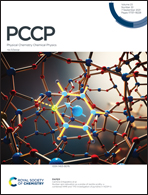Atomistic investigation on the kinetic behavior of vapour adsorption and cluster evolution using a statistical rate theory approach
Abstract
The kinetic behavior of vapor adsorption on a solid surface in an isobaric–isothermal system is investigated by means of molecular dynamics simulations combined with theoretical studies through a statistical rate theory approach. The molecular insights into the formation and evolution of clusters in the adsorbate are presented. Results show that the argon vapor is adsorbed on the silicon surface as different types of clusters. In the initial stage of adsorption, the empty adsorption sites on the surface decrease, and the adsorbed single-molecule-cluster grows rapidly and dominates the interface. The increasing rate of the adsorbed cluster and the declining rate of the empty adsorption site are dependent on the pressure ratio. For a large pressure ratio, the single-molecule-clusters are aggregated to incubate large clusters, and the fraction of a single-molecule-cluster is decreased with time. When the adsorption isotherm is determined, the chemical potential of the adsorbed cluster is expressed from the zeta isotherm model. Then the adsorption kinetics are analyzed through the statistical rate theory. The molecular exchange rate and the instantaneous driving force are calculated. The higher pressure ratio induces the larger chemical potential difference and accelerates the net adsorption rate. The adsorption kinetics derived from MD simulations are in close agreement with the theoretical analysis of the statistical rate theory.



 Please wait while we load your content...
Please wait while we load your content...